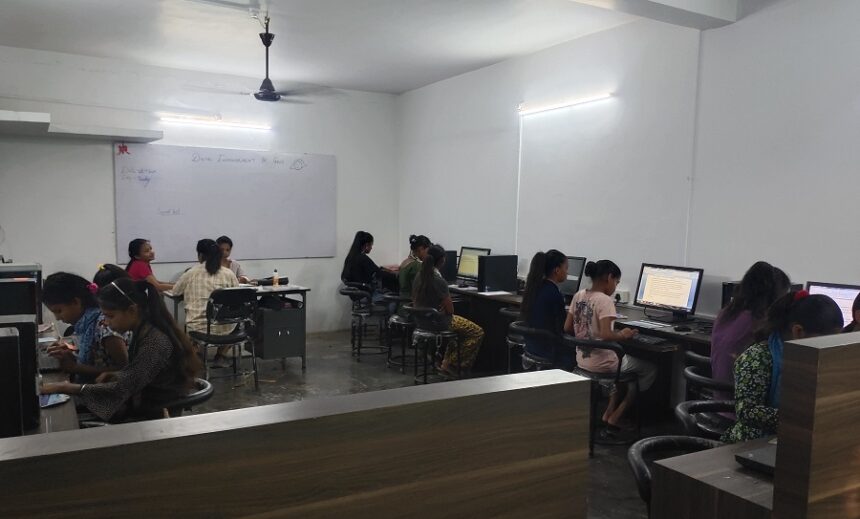Digital Empowerment of Girls in Terai Region: The Unique Way

By Colonel Satish Singh Lalotra
When digital transformation is done right, it’s like a caterpillar turning into a butterfly, but when done wrong ,all you have is a really fast caterpillar.’—George Westerman
The digital landscape in India saw its fortunes change for a better when in 1995 the ‘INTERNET’ revolution hit it with its full force only to blossom in the later years bringing in its wake a host of opportunities, raising the economy and in the bargain changing the entire thinking pattern of the sub-continent. A few tech pioneers grabbed this opportunity and explored this brave new connected world. Seven years later, on the 16th December 2002 the so called ‘Digital empowerment foundation’ (DEF) was established to connect and empower India’s one billion plus people, taking the first steps in the country’s digital development story. At that time most Indians did not have much access to information, education, and opportunities to bridge that digital divide with enough digital literacy and tools bringing an all inclusive approach to the noble mission of ‘Pan India connectivity’ which in turn led to an awakening that had the seeds of catapulting this sub-continent into a digital crazy world of today.
In 2002, less than 17 million people had access to the internet, making up only 1.5% of the country’s population. DEF/ Digital empowerment foundation set out first to change this, and in time bridge this gap through policy interventions, and on ground work. Fast forward two decades later, nearly 700 million plus people (about half of the country) are now on board this internet behemoth partaking in their wake into its benefits. According to the ‘Nielson Media’ internet report of 2023, India now boasts of the above mentioned figure of 700 million plus active users aged 2 years and above as of December 2022. Rural India has marked its presence with a whooping 425 million internet users, a number that is almost 44% higher than its urban counterparts. This remarkable growth can be attributed to factors like increased penetration of smart phones, the emergence of UPI( Unified payment interface) and government initiatives such as the ‘Pradhan Mantre Gramin Sakshtra Abhiyan’ that have facilitated internet access in even the remotest parts of the country. As a result untapped human potential is now finding room to flourish.
Despite these impressive strides, however a concerning digital divide has emerged –the gap between those who can access the opportunities of the digital economy and those who cannot. This disparity is particularly more pronounced among women and girls, as per NFHS-5 data (national family health survey) which reveals that in rural India, men are nearly twice as likely as women to have used the internet that comes in percentage terms to (49% vs 25%).This disparity is all the more pronounced when one travels in the states that are in the shadow of Himalayas. To be more precise in the states of Uttarakhand, Himachal Pradesh and UT of J&K digital divide is worrisome. To remove this disparity in a small way, a unique attempt is being undertaken by my brother in law Mr Sandeep singh Salaria by way of establishing a ‘Digital empowerment center’ at his farm house of 30 acres. Now in its third (3) year of existence, his maiden venture has taken off with the zeal that was unknown in this area of Terai region of Bazpur. Primarily started as an ode to the memory of his late dear mother, this digital empowerment center has all the seeds to flower into an excellent place for the rural girls to heed to their call of inner quest for digital knowledge and March with changing times.
The center basically erupted as an act of serendipity when Mr Salaria having observed for years the suppressed nature of rural farm girls working in his farm as also in the nearby areas decided to rope in the expertise of some of his colleagues in the school where he is still serving as one of the longest serving principal and dovetail the same to further the cause of digital empowerment of these deprived class of citizens. These girls are basically studying in the local government schools and were adversely affected by the Covid-19 pandemic in the years of 2021 that prompted my brother in law to fill in the gap of their knowledge by inducing them to take on basic computer knowledge. Since establishment of this center didn’t entail much capital expenditure being set up in his own farmhouse with the land being his own , the overheads of expenditure were met by converting his old tractor garage into an excellent class room with centrally air conditioned facilities , and provision of lap top computers, desk top computers and the tablets by partially contributions from his own pocket and the rest from his well-wishers and friends when they came to know of his embarking on such a noble mission.
As on today the center boasts of the following facilities —
- A 24×7 solar powered centrally air conditioned class room with all the modern amenities that go with a digital empowered center.
- A total of twenty 20 lap top / desk top / tablets with all the allied paraphernalia to boot up its optimum working.
- Twenty five chairs designed ergonomically for ease of operating the various computers by the girl students.
- An end to end MDF table catering to all the computers in one go.
- Two air conditioners of 1.5 tonnage capacity installed at the two ends of the room for even distribution of cool air during study periods.
- Two cameras for keeping an eye on all the girl students during their time operating on the computers.
- A coloured canon printer to cater for taking out any print out by the girl students.
- A White board with coloured markers for any explanation rendered by the teaching staff of the digital center.
- A high speed Wi-fi connectivity to increase the operating speed of the computers.
The center since its inception has been able to enroll about 25 girl students from the underprivileged class and is going steady on its course of teaching digital knowledge in its entirety. In the initial days after the inception it was left to the owner to cajole and enroll the girl students from his farm to lead the way for the rest of the lot to join hands in making this center a viable entity. It was a herculean task to bring the parents of these girl students on board and dispelling their misgivings regarding the usefulness and practicality of digital knowledge. The usefulness of mobile phones and the day to day practicality of these devices was later on drummed into the heads of these parents drawing the commonality of purpose and technology of computers as being co-terminus, which acted as a clincher in making the parents as no more fence sitters but casting their lot with the decision of the owner of the center.
This center has been able to impart the following to its girl students till date—
- Basic operating of the computer system starting with the switching on, scrolling and switching off the set.
- Teaching of various computer operations like inputting the data, processing, outputting, storing and controlling the same for a future date of usage.
- Learning of basic Microsoft activities viz Microsoft word, excel sheet making & power point presentations.
All these activities have suffused these underprivileged rural girls with a new found experience, knowledge, and are pathfinders for their families in today’s digitized world. In order to cater to the need of these girls in attending their classes at their schools and dividing time over here, the center has adapted to flexible timings and conducts these computer classes for one hour after 4 pm in the evening during the winters and from 5 pm during the summers. The overall aim of this self help center is enable these rural girls use online services and search engines to access information related to livelihood, education, health and finance, government schemes and entitlements and benefit from them.
Though having started as an ‘experiential model’ of teaching and learning , the center has been up and about in keeping its focus on its objective so carved out for digital empowerment of rural girls in the Terai region of Uttarakhand. Though only at a very modest level, a beginning has been made at least to help the rural girls also follow their call to better their lot difficulties notwithstanding. The future trajectory depends upon on policy support to ensure access, adoption, and utilization of technological tools, especially by women and girls to narrow and ultimately close the gender gap. As George Westerman has rightly said quote —‘When digital transformation is done right, it is like a caterpillar turning into a butterfly, but when done wrong , all you have is a really fast caterpillar’. Unquote.
(The writer is a regular scribe of RK and can be approached on his email:slalotra4729@gmail.com)




